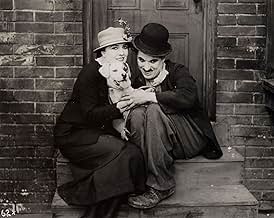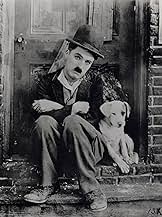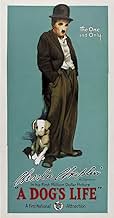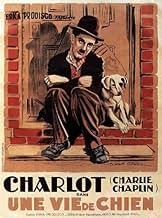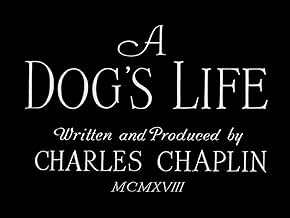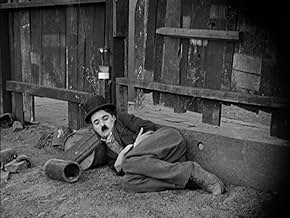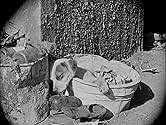VALUTAZIONE IMDb
7,6/10
10.317
LA TUA VALUTAZIONE
Aggiungi una trama nella tua linguaThe Little Tramp and his dog companion struggle to survive in the inner city.The Little Tramp and his dog companion struggle to survive in the inner city.The Little Tramp and his dog companion struggle to survive in the inner city.
Edna Purviance
- Bar Singer
- (non citato nei titoli originali)
Dave Anderson
- Bartender
- (non citato nei titoli originali)
Bert Appling
- Unemployed Man
- (non citato nei titoli originali)
Albert Austin
- Crook
- (non citato nei titoli originali)
Henry Bergman
- Fat Unemployed Man
- (non citato nei titoli originali)
- …
Alva D. Blake
- Man in Dance Hall
- (non citato nei titoli originali)
Mel Brown
- Employment Agency Clerk
- (non citato nei titoli originali)
- …
Minnie Chaplin
- Dance-Hall Dramatic Lady
- (non citato nei titoli originali)
Syd Chaplin
- Lunchwagon Owner
- (non citato nei titoli originali)
Dorothy Cleveland
- Woman in Dance Hall
- (non citato nei titoli originali)
Slim Cole
- Unemployed Man
- (non citato nei titoli originali)
Margaret Cullington
- Woman in Dance Hall
- (non citato nei titoli originali)
Billy Dill
- Man in Dance Hall
- (non citato nei titoli originali)
Margaret Dracup
- Woman in Dance Hall
- (non citato nei titoli originali)
Jack Duffy
- Man in Dance Hall
- (non citato nei titoli originali)
Robert Dunbar
- Old Man in Dance Hall
- (non citato nei titoli originali)
Ella Eckhardt
- Woman in Dance Hall
- (non citato nei titoli originali)
Recensioni in evidenza
Of Charlie Chaplin's many works, "A Dog's Life" is in my top 5, under "The Kid", "City Lights" and "Modern Times". Though just a short, I think this film is one of Chaplin's funniest and most poignant of them all. It had me laughing the whole time and this is the film that made me fall in love with his hands: It was the miming scene where the Tramp has to pretend to be the bully he's just knocked out, to get the wallet back, simply by using hand gestures! It's a moment that shines for all silent movies, showing how little sound is needed to communicate - it's a favorite scene of mine. This is a great film, and especially when coupled with "The Kid" (Chaplin's best work, I think, and my favorite film of all time) how could *anyone* refuse?
This was Charlie Chaplin's first film for First National, and with his pictures there, he could create movies of longer, or varied, length, rather than the two-reelers he was obliged to churn out before. His Mutual shorts were a vast improvement over his previous work, but watching them I'd sometimes get the sense that his ideas required more time to elaborate, to fully realize, or unfold. The hilarity of the gags in "A Dog's Life" result from this newly acquired freedom to expand his films.
I don't think it's one of Chaplin's most important works, or one of his best, but "A Dog's Life" is very funny and left me in high spirits. The crying set piece was hilarious. As well, Chaplin continued to use props and settings to his comedic advantage, such as with the missing boards and the door of his fenced home when he eludes a policeman in the beginning of the film.
Perhaps, the most interesting aspect of this one is the elaborate pantomime that goes on. The creation of the world within a silent film often created problems for lesser filmmakers on what the role of sound is within that world. There is obviously sound in the world of "A Dog's Life", but the tramp continually ignores it and oft prefers to use pantomime to express himself--or others, as in the elaborate scene using his hands. This demonstrated a lot of thought on Chaplin's part, and it's something that could be done only in the silent era. For all the comic genius in America at the time, the fact that the clowns couldn't talk shouldn't be overlooked, for it was full of advantages.
I don't think it's one of Chaplin's most important works, or one of his best, but "A Dog's Life" is very funny and left me in high spirits. The crying set piece was hilarious. As well, Chaplin continued to use props and settings to his comedic advantage, such as with the missing boards and the door of his fenced home when he eludes a policeman in the beginning of the film.
Perhaps, the most interesting aspect of this one is the elaborate pantomime that goes on. The creation of the world within a silent film often created problems for lesser filmmakers on what the role of sound is within that world. There is obviously sound in the world of "A Dog's Life", but the tramp continually ignores it and oft prefers to use pantomime to express himself--or others, as in the elaborate scene using his hands. This demonstrated a lot of thought on Chaplin's part, and it's something that could be done only in the silent era. For all the comic genius in America at the time, the fact that the clowns couldn't talk shouldn't be overlooked, for it was full of advantages.
In 'A Dog's Life' our little tramp takes care of dog, the nice touch in this movie. Other things are familiar. He encounters the police, he tries to steal food from a salesman, has money problems in a bar, has some trouble with two thugs and of course he gets the girl.
The best single moment in this short is when he pretends to be one of the two thugs. With perfect timing this a perfect piece of comedy and just this part makes the movie worth watching. There are other funny moments, especially with the dog's tale. A nice short that is a little too long. The very funny final moments (including the part with the two thugs) make sure we don't think about that too much.
The best single moment in this short is when he pretends to be one of the two thugs. With perfect timing this a perfect piece of comedy and just this part makes the movie worth watching. There are other funny moments, especially with the dog's tale. A nice short that is a little too long. The very funny final moments (including the part with the two thugs) make sure we don't think about that too much.
A Dog's Life has more layers than the usual Chaplin films, taking the character slightly more literally than he usually does. The overall appeal of Chaplin's Little Fellow is that he is such an everyman that he can be thrust into an almost endless multitude of situations, and Chaplin uses his limitless talent to mold it into brilliant, humanitarian farce. In this film, the little tramp is more of a homeless fellow than usual (I think he's usually just poor and struggling), and in the process he be-friends another homeless and struggling tramp.
There are some great scenes in the film, although even at only 40 minutes it is a bit too long for the material to support. One scene in particular, where Charlie knocks a bully unconscious, is going to be the most memorable one in the movie, along with a scene where he outsmarts some police officers. There is a charming romance that is neither cloying nor overly involving, just the right amount for a short, light-hearted comedy. This probably would have worked even better as a two reel film, but as it is it stands as one of Chaplin's better three reelers.
There are some great scenes in the film, although even at only 40 minutes it is a bit too long for the material to support. One scene in particular, where Charlie knocks a bully unconscious, is going to be the most memorable one in the movie, along with a scene where he outsmarts some police officers. There is a charming romance that is neither cloying nor overly involving, just the right amount for a short, light-hearted comedy. This probably would have worked even better as a two reel film, but as it is it stands as one of Chaplin's better three reelers.
Let's face it : Chaplin's short films, before 1917, are not so good and funny anymore. After 1917, and waiting to make longer films, there are three films I'm really found of : The Imigrant, Shoulder Arms and A Dog's Life. I love A Dog's Life because Chaplin was never trampier than in this film. He's poor, miserable, probably dirty! He really looks like a real tramp! So is his dog! The dog is simply wonderful in this film!
Funny gags all the way. I'm mad about a scene in the café, when Edna Purviance sings a very sad song and makes everybody's crying. In my version, on video, they put some strange music while she sings, like a saw sound. It's a very funny sounds effect for the image of miss Purviance! The story is very sample and warm. This is Chaplin's shorts at his best!
Funny gags all the way. I'm mad about a scene in the café, when Edna Purviance sings a very sad song and makes everybody's crying. In my version, on video, they put some strange music while she sings, like a saw sound. It's a very funny sounds effect for the image of miss Purviance! The story is very sample and warm. This is Chaplin's shorts at his best!
Lo sapevi?
- QuizThis was Charles Chaplin's first film for First National Pictures under a $1M contract where Chaplin had full creative control over his films for the first time.
- BlooperDuring the fight at the lunch cart, one of the props holding up the awning gets knocked away. In subsequent shots, the prop is back in place.
- Citazioni
Title Card: When dreams come true.
- ConnessioniEdited into The Chaplin Revue (1959)
I più visti
Accedi per valutare e creare un elenco di titoli salvati per ottenere consigli personalizzati
Dettagli
- Data di uscita
- Paese di origine
- Siti ufficiali
- Lingue
- Celebre anche come
- A Dog's Life
- Luoghi delle riprese
- Azienda produttrice
- Vedi altri crediti dell’azienda su IMDbPro
- Tempo di esecuzione33 minuti
- Colore
- Mix di suoni
- Proporzioni
- 1.33 : 1
Contribuisci a questa pagina
Suggerisci una modifica o aggiungi i contenuti mancanti

